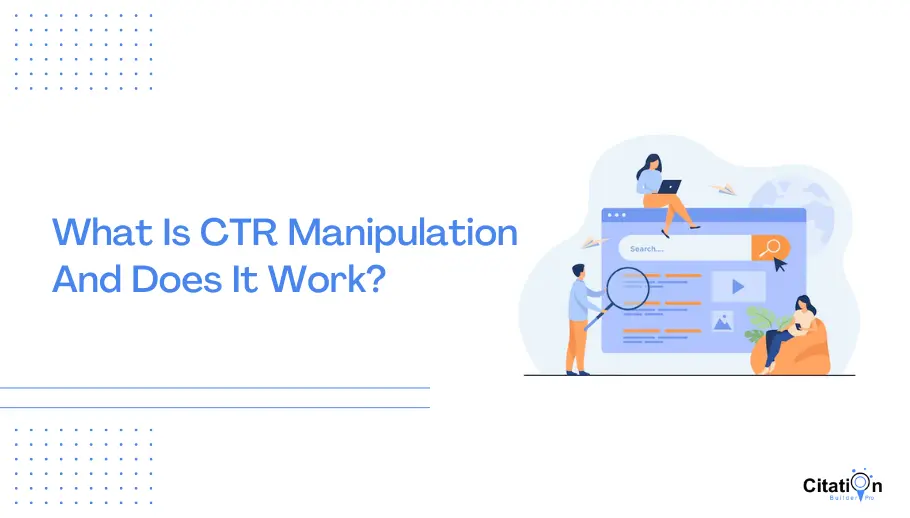Change Your Click-Through Rates with Proven CTR Manipulation Tactics
Change Your Click-Through Rates with Proven CTR Manipulation Tactics
Blog Article
CTR Manipulation: The Secret to Controling Search Engine Result
In the competitive landscape of electronic advertising, Click-Through Rate (CTR) adjustment has actually emerged as a crucial method for enhancing presence in search outcomes. A deeper exploration right into the mental factors affecting CTR, together with effective and lasting techniques, discloses a complicated interaction between prompt gains and long-lasting trust fund.
Comprehending Click-Through Price
Comprehending click-through price (CTR) is necessary for assessing the performance of digital advertising and marketing campaigns. CTR is specified as the ratio of customers who click on a certain link to the total number of customers who view a ad, e-mail, or page. This metric works as an important indication of interaction and the importance of content to the target audience.
A greater CTR typically symbolizes that the advertising and marketing technique is effectively recording attention and motivating action. Alternatively, a reduced CTR might indicate that the material is not reverberating with customers, motivating a need for assessment and prospective modification. Variables affecting CTR consist of the quality of ad copy, visual allure, and the significance of key words.
Social media ads might produce different CTRs contrasted to browse engine results. Hence, a detailed understanding of CTR is essential for attaining and driving conversions service objectives in the affordable digital landscape.
The Psychology Behind CTR
Leveraging psychological concepts can considerably enhance the performance of click-through rate (CTR) approaches. Comprehending the cognitive biases and psychological triggers that influence customer behavior is crucial in crafting material that reverberates with audiences. For example, the principle of deficiency produces necessity; individuals are extra inclined to click links that recommend limited schedule or time-sensitive offers.
In addition, social evidence plays a critical function in decision-making. When individuals observe others engaging with material-- such as via high ratings or endorsements-- they are much more most likely to do the same, strengthening the relevance of displaying positive comments plainly.
Moreover, appealing to interest can drive clicks; fascinating headings that evoke questions or highlight uncommon realities compel users to seek responses.
Moreover, knowledge types trust. Consistent branding and style throughout systems infuse confidence, making users much more inclined to click on familiar sources.
Techniques for CTR Improvement
Efficient methods for enhancing click-through rates (CTR) are important for taking full advantage of on the internet engagement and driving traffic. Among one of the most efficient methods is optimizing title tags and meta descriptions. Crafting engaging, keyword-rich titles that succinctly communicate the content's worth can significantly tempt customers to click. Furthermore, utilizing influential language in meta summaries to highlight distinct marketing factors can better boost CTR.
One more strategy includes using abundant snippets, such as star ratings, images, or various other aesthetic elements in search engine result. These improvements not just capture user focus however likewise supply beneficial info at a glimpse, making the listing much more enticing.
Including a sense of necessity or exclusivity in calls to activity can additionally boost CTR. Expressions like "minimal time deal" or "sign up with currently" can prompt instant action from potential site visitors.
Furthermore, leveraging A/B screening allows marketing professionals to constantly improve and maximize their techniques. By evaluating different headlines, descriptions, and visual elements, organizations can recognize what reverberates ideal with their target market.

Measuring CTR Performance
Measuring the efficiency of click-through price (CTR) techniques is essential for determining the success of on-line projects. Begin by tracking the general CTR, which is calculated by separating the number of clicks by the number of impacts.

Incorporating CTR data with conversion rates uses a much more all natural view of performance. Inevitably, continuous surveillance and adjustment based on CTR performance is essential for making the most of the influence of digital marketing strategies and attaining long-term success.
Ethical Considerations in CTR Control
Browsing the world of click-through price (CTR) control increases substantial honest considerations that marketers have to attend to. While maximizing CTR can boost visibility and engagement, it likewise presents the risk of misleading consumers. Ethical advertising techniques demand openness and sincerity; for that reason, manipulating CTR via deceitful methods, such as clickbait headlines or misrepresentative content, can deteriorate trust fund and damages brand name credibility.
In addition, the usage of synthetic methods to pump up CTR-- such as employing robots or incentivizing clicks-- can breach system plans and result in charges, additionally emphasizing the significance of honest conformity. Marketing experts should consider the long-term implications of their strategies on consumer connections and the general integrity of the electronic marketplace.
Furthermore, the honest click to read more landscape incorporates the broader effects of information privacy. Accumulating user data for CTR optimization without notified permission increases major honest issues. It is important for marketers to participate in responsible data techniques, making sure that customer privacy is appreciated.
Ultimately, moral considerations in CTR adjustment require a balance in between service goals and the dedication to openness, sincerity, and respect for customer civil liberties. By prioritizing moral techniques, marketing experts can foster sustainable development while keeping trust and reputation in the digital space.
Verdict
In final thought, while CTR manipulation might use immediate exposure and interaction benefits, it positions considerable threats to lasting count on and conformity with internet search engine guidelines. Lasting electronic marketing strategies should focus Read Full Article on ethical practices and real user involvement, ensuring alignment with customer interests. A balanced method that highlights transparency over misleading techniques will eventually foster long-term success in search results page supremacy, guarding brand names versus prospective charges and reputational damage.
In the affordable landscape of electronic marketing, Click-Through Price (CTR) manipulation has actually emerged as a critical technique for improving exposure in search outcomes. CTR is defined as the proportion of customers that click on a details link to the total number of users that watch a ad, web page, or e-mail . Conversely, a low CTR may suggest that the material is not read this resonating with individuals, triggering a requirement for assessment and prospective adjustment.Browsing the world of click-through price (CTR) adjustment increases considerable honest considerations that online marketers have to resolve. Gathering individual information for CTR optimization without notified permission raises serious ethical concerns.
Report this page